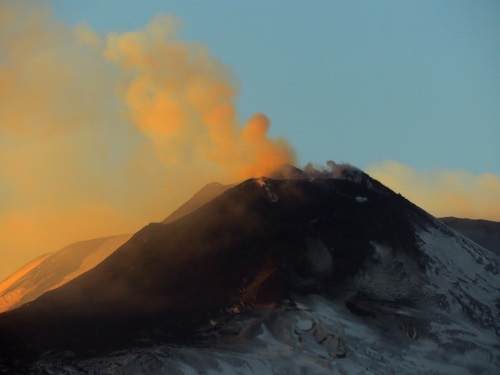Mount Etna started a new “show” between November 2020 and January 2021, as usual in a unique and charming way. It was another surprise, with phenomena and situations that attracted scientists and tourists with one question only: what is the volcano planning to do? What we know for sure is that, at the moment, all the top craters are “on” – Voragine Crater, North-East, Central, South-East (SEC) and New South-East (NSEC) – but there is only one protagonist. The newborn Sella Crater.
How was Sella Crater born?
We met the volcanologist dr. Boris Behncke from INGV of Catania and asked him about the Sella Crater. What is it? How was it born? First of all, the name “Sella” means “saddle”. This is because the vent opened between the two humps of SEC and NSEC, looking like a saddle, in fact. But its story is a very troubled one.
“This crater was born as early as February 2013, when among the many active vents of the New South-East Crater another one opened in the saddle between the old cone and the new one, still growing” says Dr. Behncke. “Then, during the many paroxysms of that year, the hole was covered with the erupted materials and seemed to have disappeared completely. Instead it continued to wake up periodically.”
Sella Crater, the new protagonist
 the collapsed side of the sella crater
the collapsed side of the sella crater
In fact, the newborn Sella Crater awakens on December 28th, 2014, so once again between January and February 2015. Finally it rested – or so it seemed – and there remained a double hole, like a horizontal 8-shaped pit. That will be also studied by volcanologists in the following two years. But it wasn’t over, yet.
“In December 2016 this vent began to give new signs of life, and it was there that the eruptive activity of February-April 2017 took place” continues the volcanologist, dr. Boris “That activity created the cone we called Cono della Sella. After the end of the activity in 2017 it had no less than three mouths; a fourth vent also added during the short activity at the end of August 2018 “.
The sudden collapse of the Sella
Between 2019 and 2020, two fractures occurred close to the SEC and NSEC structures and also affected the Sella Crater on which more holes opened. Between the summer of 2020 and the autumn of the same year, due to numerous internal collapses, all the cracks present on the crater unified forming one single large mouth.
The great eruption of 13-14 December 2020, with powerful explosions and lava emission, caused the collapse of the southern wall of the Sella Crater. The event dispersed two pyroclastic flows along the flank. Luckily they stopped at the summit, without ever endangering the foothill towns. In the aftermath of the eruption, a “balcony” was clearly visible where the southern side of the cone previously existed.
Currently the Sella Crater still looks like this, split on one side, and still very active. This suggests that it could change again, over the next few months or years. And its transformation will also cause notable changes to the top of Etna, which is constantly evolving. Once again the great Sicilian volcano proves to be an inexhaustible source of surprises and interesting motivations for scientific study, all to be discovered. (photos by Grazia Musumeci)